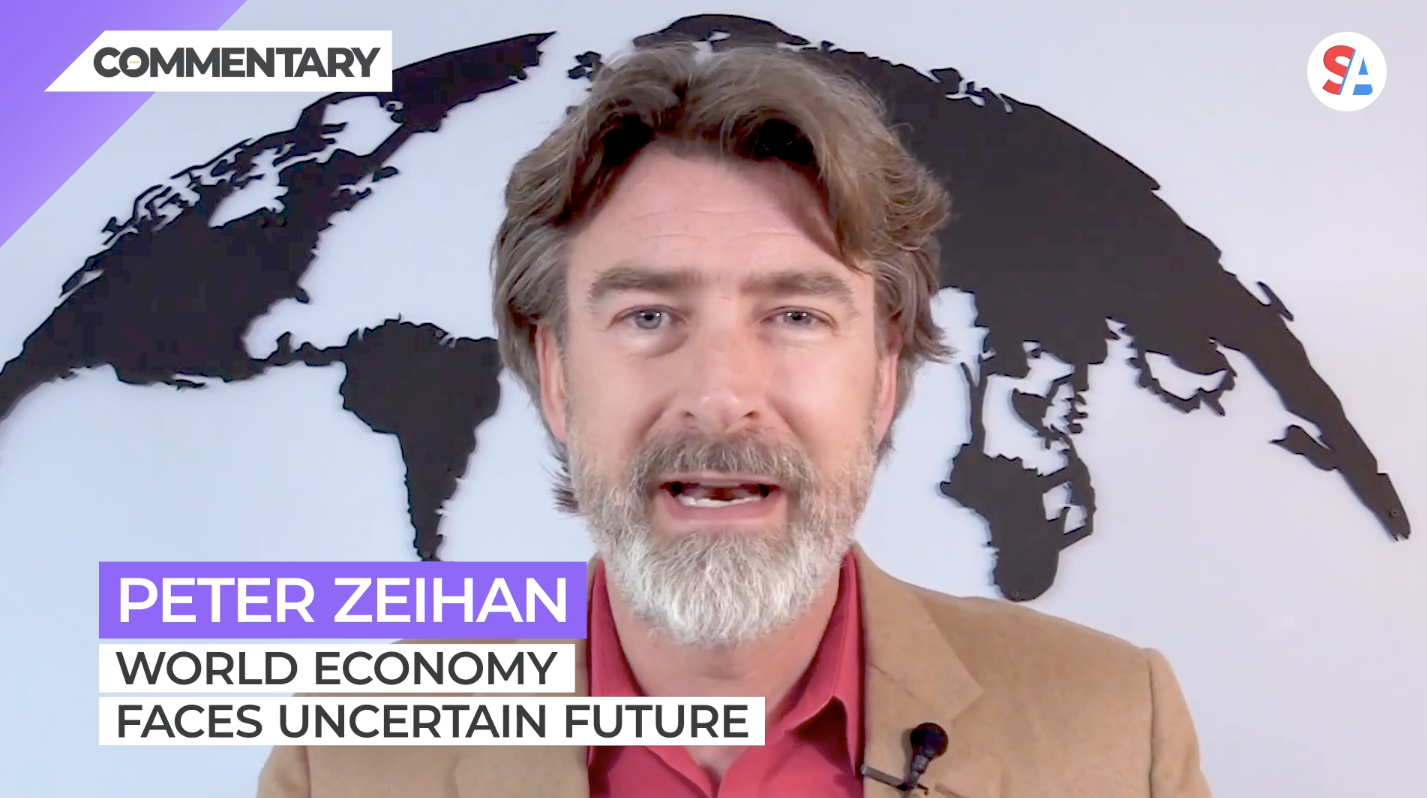
Commentary
-
Our commentary partners will help you reach your own conclusions on complex topics.
Hey everybody, Peter Zeihan here coming to you from my home in Colorado. I just wanted to get a few thoughts out there on what’s going on with American monetary policy, the Federal Reserve, and the financial sector overall.
Now with inflation at 40-year highs, it’s only a matter of time before the Federal Reserve starts some significant tightening of the system.
The Fed has already announced that they’re accelerating the eradication of their bond buying program, which right now injects tens of billions of dollars a month into the system. They’re turning it down to zero and they’re gonna put it into reverse.
So the idea that we have this supersaturation of the financial system is gonna evaporate probably before the end of March.
And the debate among the financial community is not will rates go up in calendar year 2022, will they go up four times? Will they go up six times? Will they go eight times?
The Federal Reserve would be much happier with interest rates above 3%. Right now we’re at zero. So there’s a way to go. But in order to get inflation under control, expect to see more rates that are bigger sooner. I see no reason to challenge that conventional wisdom.
And this is the sort of thing that affects absolutely everybody from a consumer point of view.
If you haven’t bought your house during the most recent binge of activity in real estate, you’re running out of runway if you’re trying to take advantage of low interest rates, cuz they’re not gonna be here for very much longer, especially as the Fed withdraws all of that stimulus into the bond market.
If you’re in the industrial space, things are getting really sketchy because we are in a period of de-population and de-globalization where the preexisting supply chains in manufacturing that span the world are becoming less and less secure and less and less functional particularly with the Chinese dropping into cult of personality economics.
That means we need to replace the industrial plant in East Asia with industrial plant in North America.
You don’t build that stuff overnight and a lot of it has to be financed. And if it’s not financed very, very soon at current low cost levels, it’s gonna have to be financed later with a greater chance of disruption at much higher levels.
So this is one of those first person, first mover advantages that people are missing the opportunity if they haven’t started already
Third, government spending. I mean, we haven’t really talked about that in the last five years ever since Donald Trump kicked the fiscal conservatives out of the Republican party, but we’ve been running record deficits now for almost a decade, by some measures, maybe even more, it’s not just Biden, it’s not just Trump. It’s not just Obama.
This goes back quite some time. And right now, if you include the COVID emergency spending, we’ve been running a 15% of GDP budget deficit for the last two, three years. That’s huge. And it means in calendar year 2021, the interest payments on the American government debt were about $550 billion U.S.
You raise interest rates, just one percentage point, that doubles.
So the time of cheap government spending is over, and now it has a compounding impact moving forward. Doubly so when you consider that the majority of the American baby boomer cadre will have moved into retirement in calendar year 2022 or 2023, instead of contributing taxes, they’re gonna be drawing pensions and healthcare.
And then of course all this cheap money that we have now had for years has encouraged certain aspects of the financial system to get really, really outta control.
My personal favorite of course is cryptocurrency. It’s not a store of value. It’s not really good for moving money from one place to another. It’s not a hard asset. In an environment where the money is basically being given away, money goes into cryptocurrency.
Money goes into things like GameStop, but that period is ending.
So if you’re one of those people who was bought into all of the hype around crypto, you are in for a very rough year.
That 50% drop in value we saw from last November to this February, this is not a one off. This is what happens when capital rules become a little bit more regularized.
Looking forward, the Federal Reserve is really the only central bank of size that is moving towards a sharp tightening. So it’s not so much how big the spread will be between U.S. interest rates and the interest rates of Japan or Europe or China.
The fact is that there is a spread, that’s what’s important.
In a normal financial system, you have a balance of producers and consumers, of capital producers and capital consumers. And as that balance moves for reasons technological or geopolitical or trade or economic cycles, interest rates rise and fall in order to regulate and try to keep the, the downs, from being too down. And the ups from being too up, whether or not they’re succeeding in that in terms of the federal reserve and other monetary authorities is up for debate. I’ll concede that point, but that’s how things are supposed to work.
But for us to have these balances, you have to have consumers. You have to have producers. With the baby boomers moving into mass retirement, we’re taking the single largest chunk of contributors to the financial system where all the savings comes from and moving them beyond the system where they’re no longer gonna have income and their investments are never going to grow again because of that. In that environment where baby boomers are retired, we don’t know what monetary theories work.
And if you look at China or Japan or most of Europe, that’s the new normal. Retirees outnumbering consumers and producers in the broader system.
And that sort of environment, they can never go above 0% entry straits again, because they will never have what we consider to be normal economic growth. The production system will be out of whack and there won’t be enough consumers to drive the system in the first place.
Now, American baby boomers did one thing different compared to everybody else’s baby boomer class.
They had kids, we know them as the millennials and they are providing a big ballast for an economic system today. They are our primary consumers.
So in the United States and uniquely in the United States, the old rules, the old guidepost of using monetary policy and interest rates still work at least for now, at least until the millennials retire in the 2050s. We’ve got time to figure this out.
But for everyone else, the economic expansions that they experienced between the financial crisis in 2008 and the dawn of coronavirus in 2020, that was it.
That was their last economic expansion according to the rules that we understand. They don’t simply need to get by with low interest rates or high interest rates or government policy.
They need to figure out a fundamentally new way to regulate the relationships between supply and demand in a world where there just isn’t very much demand. The fallback for most of these countries was to continue to sell into the United States.
But if there’s one thing that Donald Trump and Joe Biden agree on is that the days of the United States guaranteeing free trade and open markets are over.
I mean, sure. The stationaries change and Joe Biden has a better grammar checker, but he’s actually been taking Donald Trump’s policies and hardwiring them into the entire American strategic policy set and the entire American bureaucratic system.
This is our new normal, an America that is increasingly closed to the very concept of international exchange and trade. And that takes the last big piece of global consumption, the millennials, and builds a wall around it.
Normal monetary policy still works here. We’re going see that this calendar year, but it doesn’t work anywhere else. Okay. That’s it for me today until next time.
-
Peace between Israel and Iran, at least for now
A series of recent airstrikes between Israel and Iran inflamed fears of a wider regional war erupting in the Middle East. That concern now seems to have paid off, after third-party countries around the world successfully intervened and talked down military hardliners in both Israel and Iran in order to avoid such an outcome. Israel’s…
-
Global internet in a precarious state, but that could be a positive
Over 500 underwater cables span over 870,000 miles worldwide, serving as the foundation of the modern global internet. Despite their critical role in facilitating communication, these cables often go unnoticed, even as the amount of data transmitted through them has surged. So what happens if the cables fail? Straight Arrow News contributor Peter Zeihan contends…
-
Water wars are an unlikely future
Foreign policy writers have long warned of the possibility that clean drinking water might become “the next oil” — that is, that major wars might be fought around the globe over access to potable water. With expanding populations and finite water supplies, these critics argue that humans will inevitably fight each other to secure drinking…
-
Are Russia’s hypersonic missiles too good to be true?
Russia has reportedly used five of its new hypersonic Zircon missiles to target Kyiv since the beginning of 2024. Russia claims that these sea-based missiles, boasting a range of 625 miles and capable of traveling at nine times the speed of sound, are part of its family of “superweapons” aimed at penetrating the U.S. missile…
-
Norway sending F-16s to Ukraine
In recent months, the need for Ukrainian air defenses has grown more urgent. As U.S. aid is unable to pass through Congress, Ukraine’s European allies have been stepping up to provide what they can. Norway is now the latest nation to pledge F-16s to Ukraine, not only to defend Ukrainian airspace, but also for the…
Latest Stories
-
 AP Images
AP Images
Noem’s abortion comments ignored by right-leaning media, twisted by left media
-
 Getty Images
Getty Images
Pythons decimate Florida’s wildlife, is eating them the answer?
-
 Getty Images
Getty Images
RFK Jr. wants government budget on blockchain for accountability
-
 Getty Images
Getty Images
Gaza authorities claim mass graves found; Israel denies accusations
-
 Getty Images
Getty Images
Trump could lose Secret Service protection if found guilty
Popular Opinions
-
In addition to the facts, we believe it’s vital to hear perspectives from all sides of the political spectrum.
Latest Opinions
In addition to the facts, we believe it’s vital to hear perspectives from all sides of the political spectrum. We hope these different voices will help you reach your own conclusions.
The opinions published in this section are solely those of the contributors and do not reflect the views of Straight Arrow News.

















Latest Commentary
We know it is important to hear from a diverse range of observers on the complex topics we face and believe our commentary partners will help you reach your own conclusions.
The commentaries published in this section are solely those of the contributors and do not reflect the views of Straight Arrow News.
Peter Zeihan
Geopolitical StrategistGlobal internet in a precarious state, but that could be a positive
Water wars are an unlikely future
Are Russia’s hypersonic missiles too good to be true?
Dr. Frank Luntz
Pollster and Political Analyst‘Take the job seriously’: Why Americans are fed up with Congress
‘If we can shrink it, it will stop growing’: Americans talk debt, deficit
‘I don’t think they care’: Undecided voters explain their reasons
Pete Ricketts
U.S. Senator for Nebraska